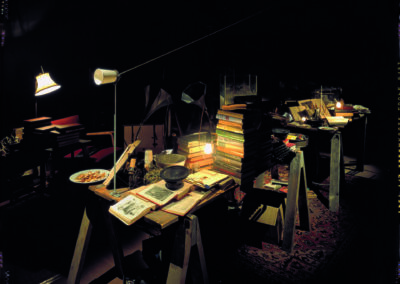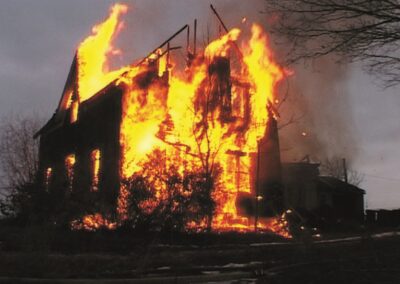Our next post regarding Artists You Need To Know is focused upon the impressive duo of Janet Cardiff and George Bures Miller.
The Canadian artists live and work in British Columbia. From their site : they “are internationally recognized for their immersive multimedia sound installations and their audio/video walks.” It is not inappropriate to say that the artworks of Cardiff & Miller have completely changed the landscape of audio art installation in Canada and beyond. In respect of the nature of their work, we’ll be sharing some stills of what they do, but as the artists create environments of sound and vision, we’ll be sharing links to many videos of their artwork to offer a more appropriate impression.
They are also prolific artists and we’ll be highlighting several of their sound installation works but a more in depth exploration of the practice of Cardiff and Miller can be done at their extensive site here.
Cardiff was born in 1957 in Brussels, Ontario, in a very rural setting : she has a BFA from Queens University in Kingston, ON (1980) and obtained an MVA from the University of Alberta (Edmonton, AB) in 1983. Her primary focus in terms of media was initially photography and printmaking, including several large-scale silkscreens. Miller and Cardiff met while the latter was attending school in Alberta, and they began to collaborate during this time. Miller was born in Vegreville, AB, in 1960 : he earned degrees from the Ontario College of Art and the University of Alberta, with his works straddling sculpture, installation and electronic arts. In 1983 the duo produced a Super-8 film called The Guardian Angel, which was among the first of their joint projects. This led to a shift in Cardiff’s work, influenced by Miller’s own practice, where “elements of narrative sequencing, experiments with sound, and movement” became major elements.
Another seminal early work by the duo was The Dark Pool, a multimedia installation from 1995 that was exhibited in Vancouver. The Dark Pool “consists of a dimly lit room, furnished with cardboard, carpets, and collected ephemera and artifacts, through which visitors move, triggering sounds such as musical segments, portions of conversations, and bits of stories.” (from here)
The images below are from this installation and a video of The Dark Pool can be seen here (click on the upper right link).
Perhaps their best known work, The Paradise Institute (2001) was first created for the Canadian Pavilion at the 49th Venice Biennale but it also toured across Canada to numerous venues. Images below are both of the exterior installation of The Paradise Institute (2001) but also some scenes from the video component of the work. A video of one of the many iterations of this project can be viewed here.
From their site : with The Paradise Institute “Cardiff and Miller focus on the language and experience of cinema. Viewers approach a simple plywood pavilion, mount a set of stairs, and enter a lush, dimly lit interior complete with red carpet and two rows of velvet-covered seats. Once seated, they peer over the balcony onto a miniature replica of a grand old movie theatre created with hyper-perspective. This is the first in a series of illusions orchestrated by Cardiff and Miller. Viewers then put on the headphones provided and the projection begins.
At least two stories run simultaneously. There is the “visual film” and its accompanying soundtrack that unfolds before the viewers; layered over this is the “aural action” of a supposed audience. The film is a mix of genres: it is part noir, part thriller, part sci-fi, and part experimental. What is more particular about the installation is the personal binaural “surround sound” that every individual in the audience experiences through the headphones. The sense of isolation each might feel is broken by intrusions seemingly coming from inside the theatre. A cellphone belonging to a member of the audience rings. A close “female friend” whispers intimately in your ear: “Did you check the stove before we left?” Fiction and reality become intermingled as absorption in the film is suspended and other realities flow in.”
Like many of their works, this description and the images are poor substitutes for the immersive and often overwhelming (in a positive sense) nature of Cardiff & Miller’s environments. In their works, the nature of the audio is more intimate, more varied and more like an experience in real life than many previous audio and immersive installations.
Another significant work by Cardiff & MIller is The Forty Part Motet (A reworking of “Spem in Alium” by Thomas Tallis 1573), (2001). The audio installation is comprised of forty separately recorded voices that are played back through forty speakers strategically placed throughout the space. The piece is a 14 minute loop (consisting of 11 minutes of music and 3 minutes of intermission). The images below are of a number of different versions of the work from sites around the world. Visitors can move in and among the speakers, so that the music is more akin to an actual live performance, but you can also overhear voices and conversations between ‘the people.’
The words of the artists : “While listening to a concert you are normally seated in front of the choir, in traditional audience position. With this piece I want the audience to be able to experience a piece of music from the viewpoint of the singers. Every performer hears a unique mix of the piece of music. Enabling the audience to move throughout the space allows them to be intimately connected with the voices. It also reveals the piece of music as a changing construct. As well I am interested in how sound may physically construct a space in a sculptural way and how a viewer may choose a path through this physical yet virtual space.”
A video of Forty Part Motet can be viewed here.
Cardiff & Miller have exhibited at the Museum of Contemporary Art in Monterrey, Mexico (2019); Oude Kerk, Amsterdam (2018); 21st Century Museum, Kanazawa, Japan (2017); Fondation Louis Vuitton, Paris (2017); ARoS Aarhus Art Museum, Denmark (2015); Museo Nacional Centro de Arte Reina Sofía, Madrid (2015); Menil Collection, Houston (2015); 19th Biennale of Sydney (2014); the Cloisters, Metropolitan Museum of Art, New York (2013); and Documenta 13, Kassel (2012). In 2011 they received Germany’s Käthe Kollwitz Prize : when they represented Canada at the 49th Venice Biennale in 2001, their work earned them the Premio Speciale and the Benesse Prize.
From an exhibition text from Museum Tinguely Basel : “The artist duo launched their now over thirty-year-long career with binaural, on-site, walkman cassette ‘audiowalks’ before turning to CD’s and since 2000 using various video devices creating a simple form of augmented reality. These perambulatory works have been described as a type of interactive physical cinema. Like our sense of smell, our acoustic memory is an accurate, high-capacity storage and retrieval system, which influences our perception and which in its openness, corporeality, and associative capacity might even be superior to our visual memory. The artists take full advantage of the auditory creating a wonderfully unbounded, open-ended walk that interacts with the physical surroundings heightening all the senses but at the same time seems very much like a meditative trance.”
Much more about their work and ideas can be seen at their site, including much more documentation of their immersive works.












